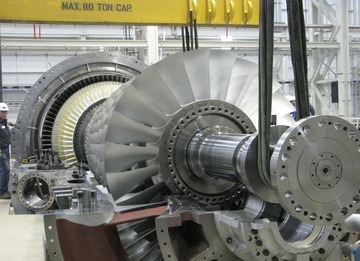 Siemens
Siemens
|
Next Challenge: What is the next wave of "dupe culture" products? |

Gas turbines have rotating and stationary blades. The stationary blades are used to guide air through the engine. Often, the first one to three rows of blades have variable guide vanes, or rotating stationary blades. Instead of rotating around the central shaft, these blades twist or pivot in place to increase or decrease the amount of air flowing into the engine and the incidence angle of the air going into the rotating airfoils.
We are looking for a new way to change this air flow. Efficiency, accuracy, and precision of this air flow profile are requirements, as this affects output, efficiency, and stresses on all of the components.
The current rotating stationary blade design is a concept has been used for decades, and we're ready for a leaner, more robust, highly reliable solution!
Successful solutions will meet these key success criteria:
- Hardware should not be in the flow path.
- For rotational designs, all blades must turn/rotate by the same amount at the same time.
- Hardware should be easy to maintain, with easy access, replacement, and repair.
- Capable of long-term use.
- Serviceability: The solution has to be retrofittable.
- Create uniform airflow.
See this video for an overview of the most recent Siemens gas turbine model:
Explain your design for the air flow control system of the future in gas turbine engines. Specifically:
- Submit a visual that illustrates your idea, demonstrating how control is achieved. Your visual should be an original, not something found online. CAD renderings or other high-quality formats are preferred.
- Explain your idea. What materials are used, how is it controlled, and what benefits does it offer?
Possible approaches include, but are not limited to, mechanical actuators with dowels, rods, hinges, and geometry dependent rotational concepts.
-
Submissions will be graded on the following criteria:
- Meets Deliverables
- Creativity
- Clarity
will share $1,000
will share $400
will share $200
| $200.00 |

|
Artur Beqiri FSHN | |
| $200.00 |

|
Joshua Y. Ansong Düsseldorf | |
| $200.00 |

|
Christopher Adjei-Frimpong University of Mines and Technology, Tarkwa | |
| $200.00 |

|
Vishal Ghoniya Gujarat Technological Univercity | |
| $200.00 |
|
Duy Tran Seattle University | |
| $66.70 |
|
Blake Graham University of Kentucky | |
| $66.70 |

|
Bolanle Dahunsi Louisiana State University | |
| $66.70 |

|
Augustine Ceaser University of Nairobi | |
| $66.70 |

|
Matthew Gaiser Queen's University | |
| $66.70 |

|
Andrei Stephenson University of the West Indies | |
| $66.70 |

|
Michael Kendall | |
| $18.20 |

|
Jeremin Stafa Tirana University | |
| $18.20 |

|
ibtsam chdhry Bahauddin Zakariya University | |
| $18.20 |

|
David Mensi Tirana University | |
| $18.20 |

|
JITHIN K V Kerala technical University | |
| $18.20 |
|
Aleksi Ouso university of nairobi | |
| $18.20 |

|
Dyllan Hancott Yorkville University | |
| $18.20 |

|
Dr. Janelle Christine Simmons Liberty University | |
| $18.20 |

|
Festus Musyoki Moi University | |
| $18.20 |

|
David Tilisho Oxford University | |
| $18.20 |

|
Jordan Patterson Duke University | |
| $18.20 |

|
Jamila Abdul Maroof |